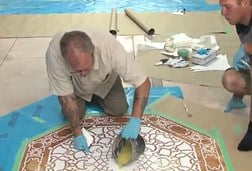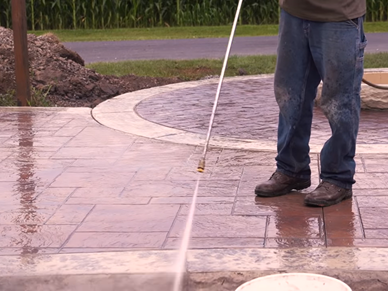How to Acid Wash Concrete
Find out if acid etching concrete is the right solution and how to do it safely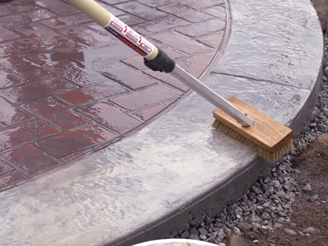
Decorative concrete expert Jason Geiser, of Deco-Crete Supply, acid washes an area of concrete to lighten the color of stain.
Acid washing is the process of removing the top layer off a concrete surface to open its pores and provide a clean slate for a coating. Read on to learn about acid washing (also called acid etching) and whether it is the appropriate treatment for your project.
Find concrete contractors near me.
Before getting into the details about acid washing, here are two questions and answers to clarify the confusion surrounding acid wash and acid stain.
Is acid washing similar to acid staining?
Acid washing and acid staining are often confused, but the two processes are very different and are used for vastly different purposes. It’s important to understand the difference.
Acid washing strips a layer off the surface of the concrete and opens the pores of the surface. It’s used as a step to prepare concrete for a decorative coating.
Acid staining is a process in which you use a stain to penetrate the surface of your concrete to give your surface a specific color or colors. Get more information about acid staining here.
Are you supposed to acid wash a surface before you apply acid stain?
No. In fact, if you acid wash your concrete before applying an acid stain, the stain will not work as well. If concrete has been acid etched, the ability of a true acid stain to take to it reduces significantly. You should only acid wash or acid etch your surface if you are preparing it to apply a non-reactive coloring methods such as a water-based stain.
Learn more about how to prepare a surface for acid staining.
Why acid wash concrete?
There are several reasons to acid wash or acid etch concrete.
To prepare a concrete slab for coatings.
Acid washing the surface of your concrete removes the following from the surface:
- Laitance (a milky accumulation of fine particles such as dust, lime, and fine sand)
- Mineral stains
- Stains from oxidation
- Contaminants that don’t wash away with water and soap
- Oil and grease
Acid should not be used as a cleaner to spot treat these types of stains. If you do that, you will etch that particular spot of the concrete and it will look different from the rest of your surface.
It’s important to note that performing an acid wash will not remove sealer from your concrete surface.
Concrete stenciling.
You can create beautiful patterns by using a stencil and acid etching gel to create a design on your stained concrete. For design purposes, you can also use it to lightly expose aggregate.
To lighten the color of stain from a concrete surface.
Sometimes when coloring concrete, the release agent sticks a little too hard and the color looks darker than you want it to. If you’re not able to get it off with a normal scrub brush or pressure washer, giving the area an acid wash can do the trick.
Watch this video to see how Jason Geiser of Deco-Crete Supply uses acid wash to lighten concrete stain.
To assist in the concrete polishing process.
Etching hard concrete floors before grinding can help make the polishing process easier. If your concrete is very hard and diamond tools aren’t cutting effectively or are glazing, consider using a concrete etcher.
Important: Acid washing will not remove concrete sealer from a surface. Instead you’ll need to use a chemical stripper. Learn more in How to Remove Concrete Sealer.
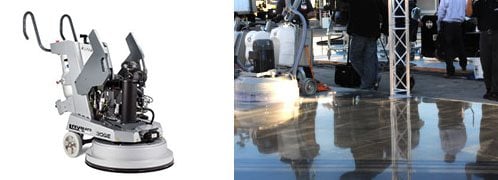 Propane Grinding Machines
Go cordless with the LAVINA elite series
Propane Grinding Machines
Go cordless with the LAVINA elite series
 Concentrated Concrete Cleaner
Clean and profile concrete in a single step
Concentrated Concrete Cleaner
Clean and profile concrete in a single step
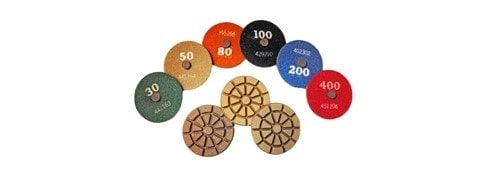 Surface Prep Diamonds
Superior floor with reduced steps
Surface Prep Diamonds
Superior floor with reduced steps
 CPS G-170 Electric
17" Floor Grinder 230 volt ($7,600)
CPS G-170 Electric
17" Floor Grinder 230 volt ($7,600)
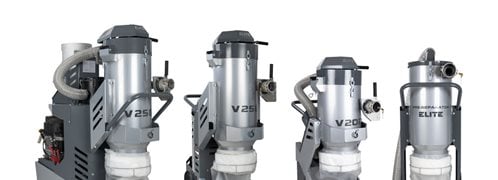 LAVINA® ELITE Vacuums
Ranging from 16" to 32"
LAVINA® ELITE Vacuums
Ranging from 16" to 32"
What is the best way to etch concrete?
Here, we provide an overview of how to etch concrete (also known as acid washing).
To reiterate an important point: Before you begin the etching process, be sure to take all the precautions necessary to protect yourself and your surroundings. Acid is a caustic product that can cause harm.
Protect yourself from acid splashing by using the following:
- Face covering (a mask with a respirator is recommended)
- Protective goggles
- Gloves
- Long-sleeved shirt, pants, and close-toed shoes
Materials needed
- Scrub brush
- Large bucket to mix acid and water
- Acid
- Power washer
- Clean water
- Baking soda or trisodium phosphate (tsp)
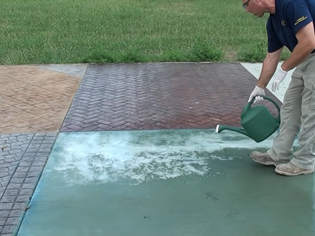
Muriatic acid solution being carefully poured onto the concrete surface using a watering can. Brickform / Solomon Colors.
Instructions:
- Protect any plant life nearby to avoid killing it with the acid solution.
- Prepare your materials
- Mix acid solution: 1 parts acid to 10 parts water. Always pour acid into water to avoid acid from splashing.
- In another bucket, mix neutralizing solution: 5 gallons of water for every 1 pound of baking soda.
- Prepare your surface by misting it with water. This step will further dilute the acid so it’s not so strong. It also allows for a nice, even application of the acid.
- Slowly pour the acid solution onto your concrete surface. You can do this right from the bucket, or you can use another means such as a watering can. You’ll notice the acid fizzing.
When it stops fizzing, it’s time to neutralize the surface. It’s important not to leave the acid on the surface for too long. If you do, you run the risk of remaining on the surface and negatively impacting your concrete or the coating you’re planning to apply. - Distribute the neutralizing solution on your concrete surface. You’ll see it begin to neutralize the acid.
- When you don’t see any fizzing or bubbling and the surface is properly neutralized, it’s time to pressure wash the surface. At a minimum, you want to use 3,000 PSI at 4 gallons a minute. Use a fan tip for best results.
These instructions were created based on the following surface preparation video from Brickform. Watch the video to get a demonstration of how an acid wash should be completed.
What type of acid should be used for acid washing?
We don’t recommend using one type of acid over another, but here is some general information about the types of acid available. The two types most commonly used for acid washing or acid etching are hydrochloric acid and phosphoric acid.
- Hydrochloric acids are very harsh and should always be used with caution. You may have heard of using muriatic acid on concrete—muriatic acid is a particular type of hydrochloric acid.
- Phosphoric acids are milder than hydrochloric acids and can also be used for acid washing.
- Acid etching gels are available for detailed decorative projects.
Always read the Material Safety Data Sheet (MSDS) for any product to check for potential hazards and health effects.
Consider using a safe alternative to acid etchers, like Eco Concrete Profiler from Versatile Building Products or E-Etch, a light etching product from Brickform.
Does vinegar etch concrete?
Vinegar is a very mild acid, so it would not be effective for acid washing your concrete surface.
Downsides of acid washing concrete for surface prep
Acid washing used to be one of the top recommended ways to prepare a concrete surface for a coating or water-based stain. Over time, though, industry professionals have found that in most cases* grinding a surface is just as effective for cleaning and opening its pores to accept a coating, paint, or water-based stain. Additionally, grinding a surface is seen as less disruptive to the integrity of the concrete surface than acid washing.
Here are some reasons grinding is preferred over acid washing:
- Acid washing or etching the entire surface can make it too porous, making it easier for water to seep in when you wash the acid off the slab.
- Using acid can be dangerous. There’s a risk of chemical burns and acid inhalation. If you do decide to do an acid wash, you must take proper precautions to protect yourself.
- If the acid isn’t neutralized completely, it’s possible that it will weaken the strength of the concrete over time.
- It’s easier to control a grinder than it is to control acid, so the surface often ends up being smoother when you grind it.
- Acid can harm nearby plants if it gets on them, so if you’re attempting to acid wash a concrete patio, you’ll need to be mindful of this.
*There are times when a surface is tightly troweled and it’s difficult to adequately strip the surface with a grinder. In these situations, an acid wash is sometimes preferred.
Learn more about grinding concrete.
Does etching concrete clean it?
While acid washing/etching does technically clean a surface by removing contaminants, it is really intended to create a surface profile and should not be used as a general-purpose cleaner. It should only be used if you intend to strip the surface, open the pores, and apply a new coating. And even then, it should be used when grinding the surface isn’t possible (see more below).
You can read more about the appropriate methods for cleaning concrete here.
What happens if you don’t etch concrete before an epoxy coating is applied?
Acid etching concrete is an option but not a requirement for epoxying a concrete surface. If you plan to epoxy your garage floor, for example, it does need to be thoroughly cleaned and free of contaminants, and the pores need to be opened. Acid etching is just one way to do this, but it’s not the only way.
Another option would be to use a grinder to open the pores of your concrete surface. For DIYers, though, getting ahold of a grinder isn’t an easy task. That’s why some prefer to do an acid wash for concrete etching.
If you do decide to acid wash your concrete floor, be sure to heed all precautions and follow instructions carefully so you don’t harm your concrete surface—or yourself.
